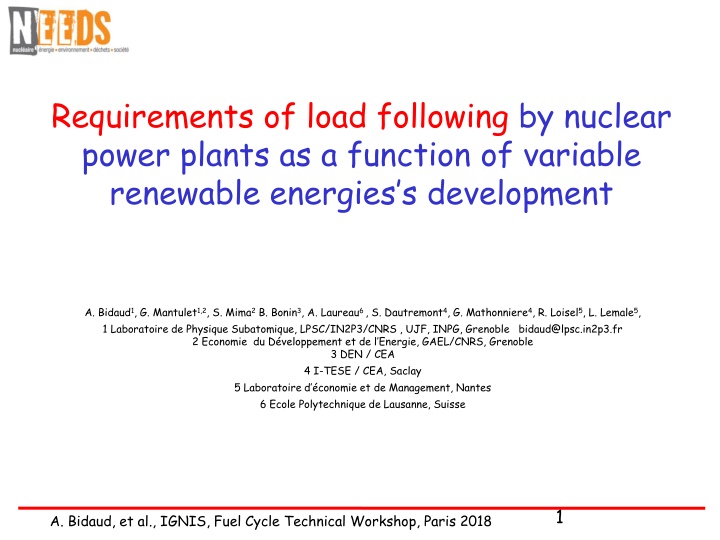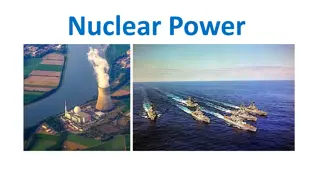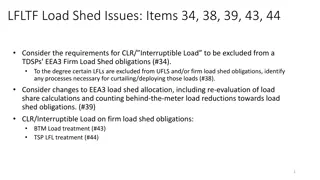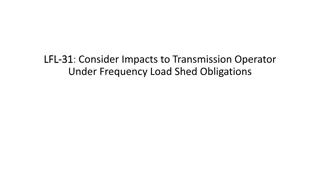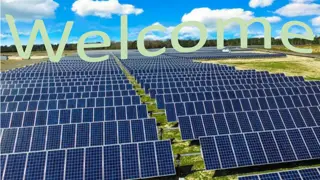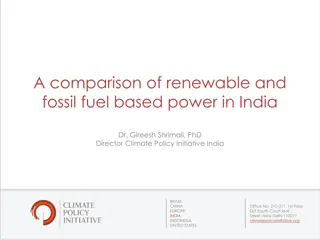Load Following by Nuclear Power Plants in Relation to Variable Renewable Energies' Development
The study explores the requirements of load following by nuclear power plants in the context of variable renewable energies' growth. It discusses the impact of renewable energy development on nuclear economic models and the need for dispatchable capacities. Benchmarks are set to test robustness of dispatch models and estimate load profiles with high variable renewable energy. Various scenarios and comparisons are made between different benchmarks to analyze load profiles and production capacities based on variable costs.
Uploaded on Sep 15, 2024 | 1 Views
Download Presentation

Please find below an Image/Link to download the presentation.
The content on the website is provided AS IS for your information and personal use only. It may not be sold, licensed, or shared on other websites without obtaining consent from the author.If you encounter any issues during the download, it is possible that the publisher has removed the file from their server.
You are allowed to download the files provided on this website for personal or commercial use, subject to the condition that they are used lawfully. All files are the property of their respective owners.
The content on the website is provided AS IS for your information and personal use only. It may not be sold, licensed, or shared on other websites without obtaining consent from the author.
E N D
Presentation Transcript
Requirements of load following by nuclear power plants as a function of variable renewable energies s development A. Bidaud1, G. Mantulet1,2, S. Mima2B. Bonin3, A. Laureau6 , S. Dautremont4, G. Mathonniere4, R. Loisel5, L. Lemale5, 1 Laboratoire de Physique Subatomique, LPSC/IN2P3/CNRS , UJF, INPG, Grenoble bidaud@lpsc.in2p3.fr 2 Economie du D veloppement et de l Energie, GAEL/CNRS, Grenoble 3 DEN / CEA 4 I-TESE / CEA, Saclay 5 Laboratoire d conomie et de Management, Nantes 6 Ecole Polytechnique de Lausanne, Suisse 1 A. Bidaud, et al., IGNIS, Fuel Cycle Technical Workshop, Paris 2018
Renewable growth Real Simulated Fossils and nuclear are forced out If top priority is nuclear phase-out, CO2 emissions increase ! (see Belgium/France Transport System Op reports not only soccer games !) Grids need more dispactchable capacities. What would Load profiles look like ? (this talk) How might Nuclear Economic model be impacted ? (see R. Loisel in 15 minutes) Production capacities pile up as a function of their variable costs : 0 < solar/wind < hydroS < nuclear < fossils 2 et al.A. Bidaud, et al., IGNIS, Fuel Cycle Technical Workshop, Paris 2018
Benchmarks Goal = compare/test robusteness of dispatch models + estimate load profiles with high VRE 1. Benchmark 1.0 : Reproduce year 2012* Demand = French Production (including exports/imports so that) Capacities (GW) = French TSO Data + ajustements for fast growing renewables Renewable production profiles: Wind + solar = 2012 real data Pumped/Lake/Run-of-River Hydro = Model dependant Availabilities for dispatchables : Model Dependant Marginal Costs (MIXOPTIM) outputs = Average load factors needed for CO2 + Cost estimations 2. Benchmark 2.0 : Reproduce Year 2030 POLES Baseline (Nuclear = 50% of electricity) Demand = 2012 scaled up to POLES 2030 (513TWh/y-> 730 TWh/y) Capacities = POLES 2030 (more fossils !) Availability factors = 2012 3. Benchmark 3.0 : Scenario AMPERE of RTE (French TSO) Same as 2.0 but based on French TSO assumptions 50% nuclear but with strong Renewable increase => strong reliance on interconnections *peak record in february during cold wave 3 et al.A. Bidaud, et al., IGNIS, Fuel Cycle Technical Workshop, Paris 2018
Bench 1.0 2012 UCAD (Grenoble) MAEL (CEA Saclay) MIXOPTIM (CEA ) Production annuelle (TWh) Nantes 2012 RTE Production annuelle (TWh) Production annuelle (TWh) Production annuelle (TWh) Production annuelle (TWh) Fili re Nuclear Coal Gaz Fioul 404,9 18,1 23,2 6,6 407,3 25,54 15,02 4,04 407,4 28,6 14,4 0,36 376,7 16,9 30,1 6,6 414,1 8,6 23,1 5,3 Run-of-River 46,1 28,3 24,8 63,8 56,7 Lake 15,99 23 50,3 PumpingStor Wind Solar Other Renew total CO2 Emissions(MT) -0,51 14,5 3,8 1,69 532,76 34,35 0,45 14,0 3,7 1,9 12,4 2,3 4,3 526,3 33,04 14,9 4 5,9 14,9 3,8 6,4 Inclus dans charbon 541,4 31,42 520,6 33,2 532,76 21,38 Nuclear : Limited discrepencies thanks to adjustments of Availability factors : Nantes = daily Max = Observed max UCAD max = 0,8 Max MIXOPTIM = observed distribution (including average) Hydros : discrepencies in modeling/affectations Fossils : Ramping capacities discrepencies Are Dips OK ? NB : UCAD : PV+wind capacties are thos of end of 2011, with 2012, PV = 3,61TWh et wind = 14,1TWh NB in UCAD, les STEP ont des contributions n gatives InMAEL, one week(and associated energy) is missing! 4 et al.A. Bidaud, et al., IGNIS, Fuel Cycle Technical Workshop, Paris 2018
Hydros lake Hydro Mod lisation stock hydraulique difficile Other Water uses (irragation, low water minimum flow, tourism ) Sustained Minimum = Run of River ? Approche EUCAD (MAEL) => Daily usable volumes Run-of-River Not Flat at all! Noticeable lake contribution ! Pumping Storage Not Flat at all ! Some have a strong (dominant) lake- like contribution ! 5 et al.A. Bidaud, et al., IGNIS, Fuel Cycle Technical Workshop, Paris 2018
Bench 2.0 2030 - 50% nuclear Parc / Demand from baseline scenario POLES 2030 UCAD MAEL MIXOPTIM Production annuelle (TWh) Nantes 2030 Puissance POLES Installed Power Production annuelle (TWh) Production annuelle (TWh) Production annuelle (TWh) Fili re Nuclear Coal Gaz Fioul Run-of-River Lake PumpingStor Wind Solar Other Renew total 44 385 95 27,7 3,7 46,1 15,99 -0,51 348 123 108 11 28,3 23 0,7 18 343 44 77 329 74 91 1,5 13,4 34,4 3,3 6 34,8 55,1 0,9 74 Idem 2012 : 25,5 55 39 6,7 15,5 72 86 7 5 7 8 52 Inclus dans charbon 60 60 702 702 180 GW 702 667 CO2 Emissions(MT) 104 168 77 107 Parc / Demande = POLES 2030 => Increasing Demand (+70%), very strong increase of VRE capacities (and of fossils !), nuclear power slightly reduced => Lots of discrepencies (e.g. hydro ), difficulties to tune Availability factors etc => CO2 emissions strongly growing 6 A. Bidaud, et al., IGNIS, Fuel Cycle Technical Workshop, Paris 2018
Bench 3.0 2030 - 50% nuclear Parc / Demand = AMPERE @RTE 2030 RTE UCAD Nantes 2030 AMPERE Puissance install e consid r e Production annuelle (TWh) Production annuelle (TWh) Production annuelle (TWh) Fili re 48,5 307 316,6 317,8 Nuclear Coal Gaz Fioul Run-of-River Lake PumpingStor Wind Solar Other Renew 0 0 0 0 11,7 2,2 33 33,1 21,9 1,97 2 4 42 16 Idem 2012 : 25,5 59 59 -0,9 94 38 15,0 52,1 36 3,5 134,5 43,1 15,4 124,62 43,1 13,53 Curtailment 12 1,7 EnotDistributed Parc total 13,9 583,6 179,5GW 583,6 583,6 CO2 Emissions (MT) 14,7 16,2 10,2 Parc / Demande = AMPERE @RTE 2030 => Stable internal demand (but increasing exports !), reduction of fossil capacities => simpler parc => smaller discrepencies => Global coherence with French TSO despite no modelisation of imports/exports and storages (Electric Vehicules) / Demand Response 7 A. Bidaud, et al., IGNIS, Fuel Cycle Technical Workshop, Paris 2018
Impacts for Nuclear Shift from base load to semi-base and even peak ! 0 Power is more and more likely ! Frequent occurrences of deep hourly/daily variations => Tr s fortes contraintes pour : - le r seau (interconnections) - les moyens pilotables => Stockage n cessaire (Vehicules lectriques) 8 et al.A. Bidaud, et al., IGNIS, Fuel Cycle Technical Workshop, Paris 2018
Conclusions Lessons learnt: Are the outputs / assumptions ? Are Availibility factors constants ? Probably not ! Functions of random variables Load/competitors strategies, water stocks availability etc that operators anticipate ! Benchmark baseline POLES 2030 (50% nuclear, increasing demand) => More Renewables but increased demand and more fossils to cope with both ! =>Increasing nuclear load factors ! Benchmark Ampere 2030 @RTE (Stable demand, lower fossils) => Increase of Domestic Production (for exports) AND lot of non distributed (lack of) energy without interconnection modeling! => threshold of pain (I. Kocher @ ENGIE) probably by 30% of renewables (A. Bidaud hypothesis when share close to load factors) 9 et al.A. Bidaud, et al., IGNIS, Fuel Cycle Technical Workshop, Paris 2018
Merci de votre attention ! Thank you ! 10 et al.A. Bidaud, et al., IGNIS, Fuel Cycle Technical Workshop, Paris 2018
Pntration des renouvelables France 2014 2050 Evolutions: disparition de la base importance des capacit s de pointe (1/2 des dispatchables) Disparition du nucl aire ? R duction de la projection de nouvelles capacit s (co ts de construction plus lev s que dans les ann es 80) Bidaud et al @ ICAPP 2016 disparition de la base importance des capacit s de pointe (1/2 des dispatchables) Disparition du nucl aire ? +- 7% R serve tournante t l r glage +- 70% nights / weekends load following Historique de production de 1 r acteur Programmation saissoniere des arr ts de tranche pour s adapter la demande OECD NEA Nuclear and Renewables 11 et al.A. Bidaud, et al., IGNIS, Fuel Cycle Technical Workshop, Paris 2018
